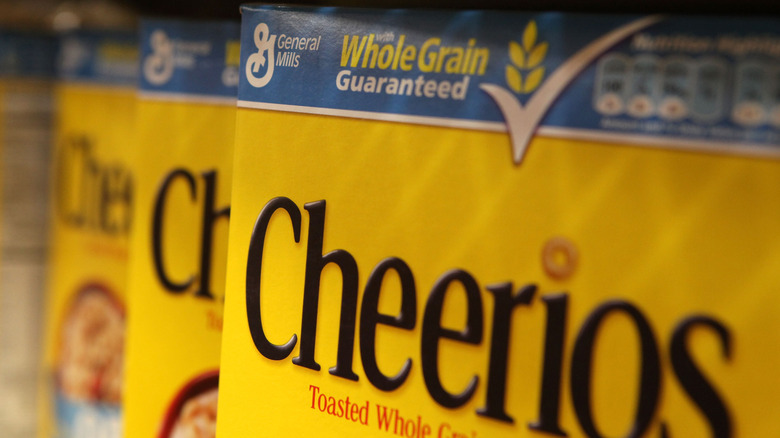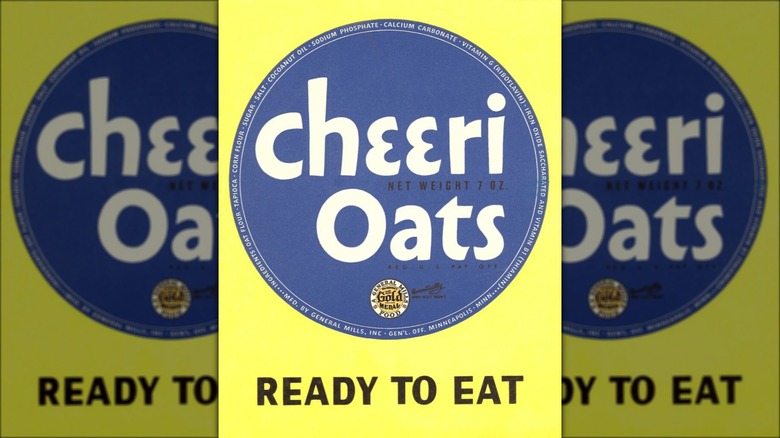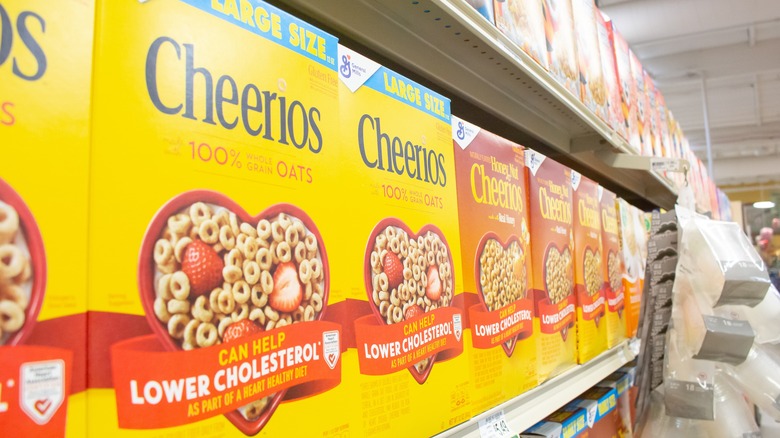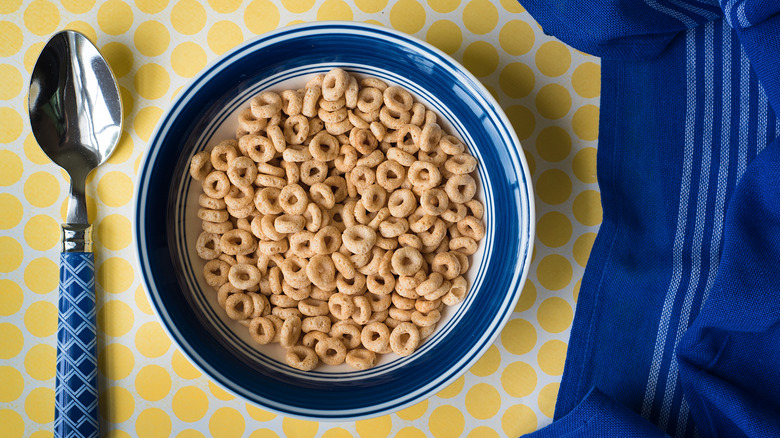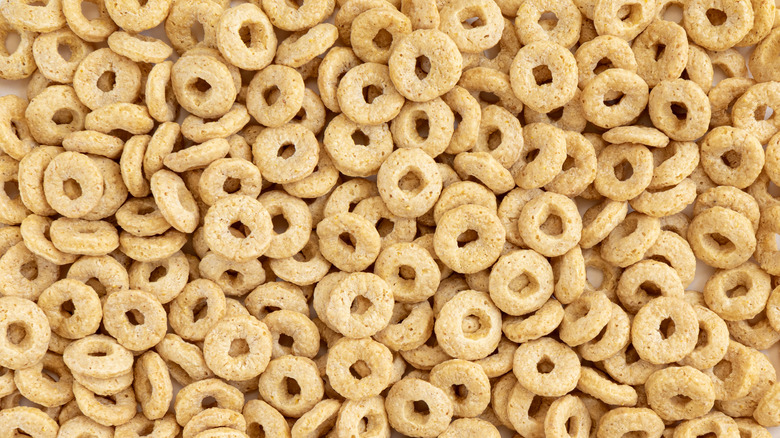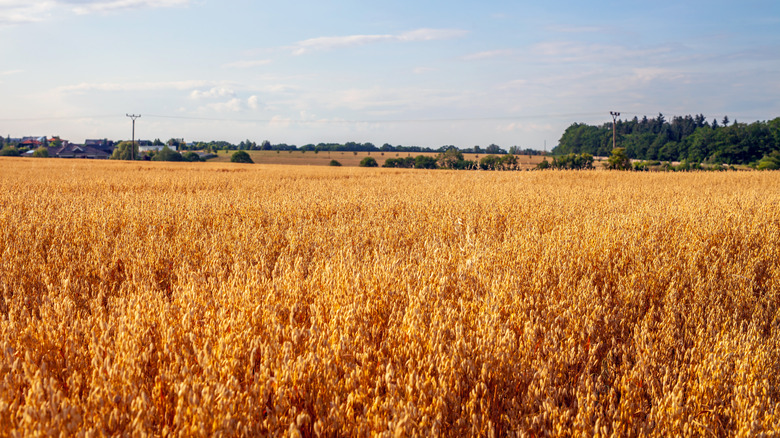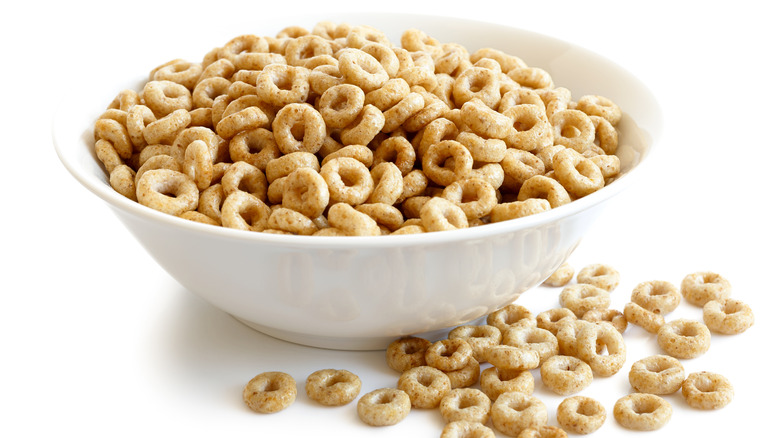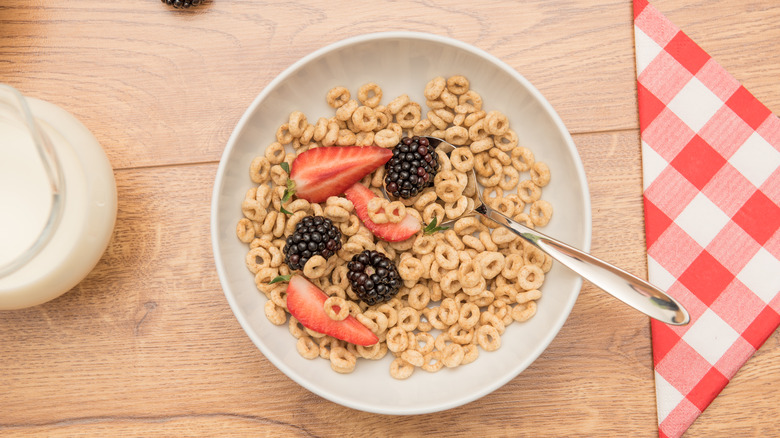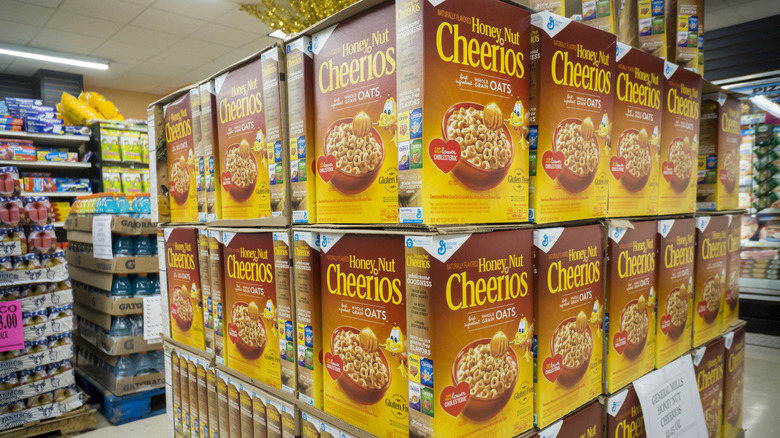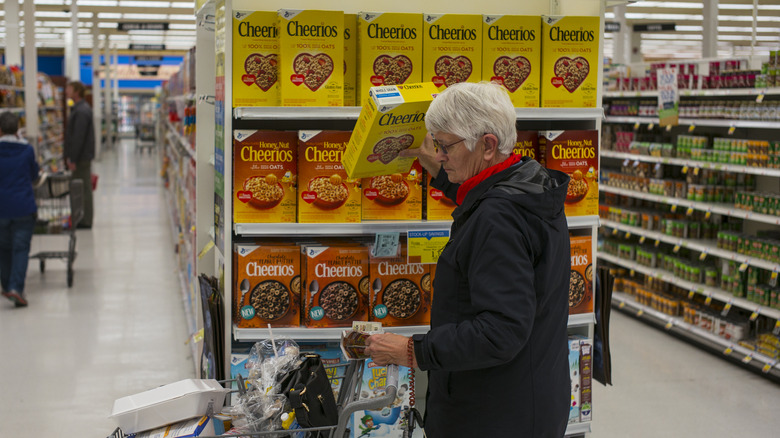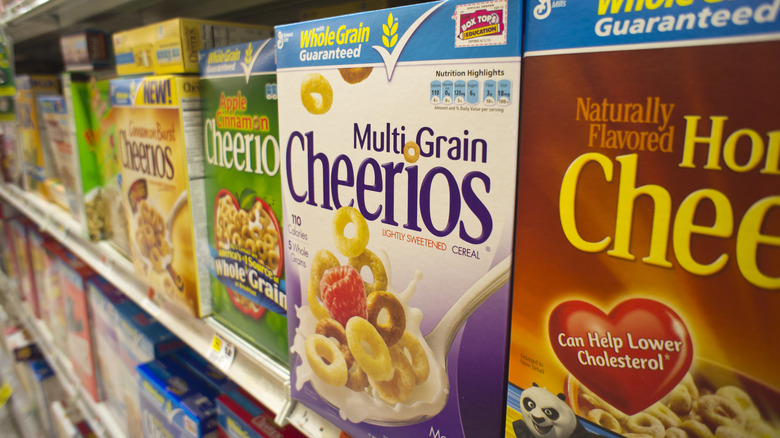Myths About Cheerios You Thought Were True
You might've had crunchy, oat-filled Cheerios as your first bowl of cereal as a baby, and chances are they'll be well stocked in the retirement home where you live out your golden years. In between, your pantry has likely seen its share of yellow Cheerios boxes, too, especially if you've ever raised children in need of a quick breakfast or on-the-go snack. The iconic O-shaped cereal has become synonymous with early-morning sustenance, late-night snacks, and even dinner in a pinch.
Cheerios are one of the most beloved cereal brands in the United States. The truth about Cheerios — whether your favorite is the classic, the sweeter Honey Nut sister, or any number of the best Cheerios flavors now on shelves — is that this cereal is pretty hard to ignore at the grocery store. The brand of best-selling cereal has been sold by General Mills since 1941 and shows no signs of faltering in its popularity.
While Cheerios might be one of the most popular cereals on shelves today, there are some myths floating around about the brand. Some are pretty innocuous, while others make some serious claims about the health effects of the brand that's touted as a family favorite. We set out to debunk some myths about the Cheerios brand you thought were true and bring you the facts about the cereal in your bowl. We also reached out to General Mills for comment and included the company's responses to set the record straight.
Myth: The cereal was always called Cheerios
While most of us can't remember a time without the ubiquitous bright yellow box of Cheerios with its heart-shaped bowl of Os on the front, even Cheerios went through an identity crisis. Or, we should say, an early-life name change. When Cheerios first hit the market in 1941, they were actually called "CheeriOats." In fact, you probably wouldn't recognize the first Cheerios box and label, which featured a blue circle with the original name prominently displayed, along with a pale yellow background and the words "ready to eat" plainly typed along the bottom.
While "ready to eat" sounds a bit obvious to those of us who grew up with bowls of cereal at the breakfast table, Cheerios was one of the first sources of oats that didn't require cooking on the stovetop. One of its main breakfast competitors in the '40s, Quaker Oats, hadn't yet created the process for making instant oatmeal. Still, Quaker Oats took issue with the CheeriOats moniker, claiming trademark infringement for using "oats" in the name. General Mills ended up changing the name to a simpler "Cheerios" in 1945, and the rest is cereal history.
Myth: Eating Cheerios will automatically lower your cholesterol
Though Cheerios today are marketed in part as a beloved children's snack staple, they persist in many adults' diets as well. At least one of those reasons is because all Cheerios contain whole grain oats as the main ingredient as well as soluble fiber, both of which can be beneficial for your cholesterol levels. But it's not as easy as eating some Cheerios and waving around some magical fairy cereal dust while you fill up on a pound of artery-clogging bacon.
Cheerios have been touted as a heart-healthy cereal option for decades — hence the red heart-shaped bowl on the front and even the occasional heart-shaped cereal. But in 2009, the Food and Drug Administration (FDA) slapped General Mills on the wrist for claiming that eating Cheerios would lower cholesterol by 4% in six weeks. The FDA warned that such claims put Cheerios in the category of an official cholesterol-lowering drug, which, of course, it is not.
Since then, General Mills and Cheerios have been careful to say that eating Cheerios "as part of a heart-healthy diet" can help consumers achieve their cholesterol goals. Eating 3 grams of soluble fiber per day in a diet already low in saturated fat and cholesterol can reduce the risk of heart disease. According to the brand, Cheerios provides 1.5 grams of soluble fiber per serving. A fairy wand it is not, but the cereal can still be one of the healthy choices you make.
Myth: Honey Nut Cheerios contains almonds
Nope, there's not a single nut in that entire box of Honey Nut Cheerios goodness — even though the name suggests otherwise. According to Consumer Reports, Honey Nut Cheerios did contain actual ground almonds until around 2006, though today the ingredients list only mentions natural almond flavor.
This natural almond flavoring can come from actual almonds, but it can also come from the pits of peaches and apricots. According to Consumer Reports, the stone fruits are actually where most natural almond flavoring comes from.
If that's the case, why does General Mills put an allergy warning on each box saying "contains almond ingredients?" When we asked the company about it, representatives said Honey Nut Cheerios are still technically not nut-free, even though they don't contain almonds or almond pieces. "The almond flavor contains ingredients derived from real almonds, and the ingredient is labeled "Natural Almond Flavor," they wrote in an email. In other words, you won't bite into any nuts while enjoying a bowl of this cereal, but if you're sensitive to almonds and tree nuts, it's still best to enjoy other Cheerios varieties.
Myth: The 'O' shape was part of the original cereal design
What is a Cheerio without the actual "O"? Apparently, still (almost) a cereal. The doughnut-like circle that makes the cereal so easy to pick up as a finger food at an early age and universally appealing in cereal bowls for all ages was almost a completely different shape entirely.
When General Mills was cooking up the recipe for the original Cheerios, the company didn't automatically land on the now-iconic "O" shape. Food scientists tested out more than 10 shapes and sizes for the burgeoning cereal. Those included squares, multiple numbers of pointed star shapes, and even spirals. In the end, though, the shape we now consider the right one was chosen simply because it fit well into the packaging.
Since the earliest days, General Mills has used machines dubbed "puffing guns" to churn out mountains of little toasted Os for consumption. Operators stood by giant metal tubes that would come up to certain pressure and heat points, then shoot out a barrage of cereal ready to be packaged. Perhaps somewhat surprisingly, those machines really haven't changed all that much since the '40s and '50s. "It's been modified; it's been tweaked, but it's basically the same technology since the beginning," Susan Wakefield, the corporate archivist at General Mills, explained about the history of the O-making machinery in one YouTube video.
Myth: All oats for Cheerios are naturally gluten free
The only grain ingredient in all Cheerios products is oats, and oats in their purest state are gluten-free. However, General Mills still needs to go above and beyond to ensure it can actually put the gluten-free label on every Cheerios box. The reason is because mills that process oats also tend to process grains such as wheat and barley that are not gluten-free. As a result, oats that are not specially processed run the risk of cross-contamination. "Oats without a gluten-free label are not considered safe for those who have celiac disease," the advocacy website Beyond Celiac states.
To label boxes as gluten-free, the FDA required General Mills to develop a process to eliminate any cross-contamination from its oat products. The cereal company uses technology that sorts grains in its cleaning house by size and shape to ensure that only oats end up in the Cheerios flour mix. The cleaning house sorts up to 3.5 million pounds of oats each day, and the flour continues to be tested at various points in the manufacturing process to ensure General Mills meets the FDA's standards for providing gluten-free foods.
Some parents on forums about Cheerios report their children with wheat allergies or other food sensitivities still had adverse reactions to eating Cheerios, though it's not clear why. It's always good to pay attention to what your child eats and avoid foods that cause issues.
Myth: There are toxic levels of chemicals in Cheerios
In 2019, rumors circulated that Cheerios contained toxic levels of glyphosate, a pesticide found in products like the weed killer Roundup. The information seemingly originated with a paper published by the Environmental Working Group, though the claim has taken on a life of its own in online forums like Reddit since that time.
Though initial headlines seemed startling, the paper was roundly debunked by numerous toxicologists. The Genetic Literacy Project explained that the EWG's "safety threshold" for glyphosate levels it tested was 100 times lower than the most conservative thresholds used by other agencies, including the Environmental Protection Agency. The group also criticized the EWG's "historical willingness to distort science." The EPA itself states "there are no risks of concern to human health when glyphosate is used in accordance with its current label." Another toxicologist looked at the original claims for a CBS News affiliate and found that a person would need to eat 158 pounds of Cheerios every single day to reach even 1% of the levels of potential risk from glyphosate exposure. To summarize, it's physically impossible to eat enough Cheerios to cause any harm from glyphosate: You're more likely to risk a stomachache first.
General Mills responded with the following when we asked about this now-debunked rumor: "All our products adhere to all regulatory requirements. Food safety is always our top priority at General Mills, and we take care to ensure our food is prepared and packaged in the safest way possible."
Myth: Eating Cheerios automatically promotes weight loss
Many people jumpstart their weight-loss goals with a bowl of Cheerios in the morning, but it doesn't mean Cheerios alone are going to make a dent in your waistline. Like the claims about lowering cholesterol, eating Cheerios to lose weight should come with a disclaimer.
According to Livestrong, starting your day with a balanced breakfast can be helpful in losing weight. The publication notes studies that show people who lost weight (and kept it off) incorporated breakfast into their normal routines. And since Cheerios are low in fat and high in fiber, Livestrong suggests the breakfast cereal could provide benefits.
Mayo Clinic backs this up to a point. One weight loss tactic is to eat low energy-density foods. These are foods that have a low amount of calories for the volume of food that you're eating. If you do that well, you'll feel full on a lower amount of calories, which can lead to the calorie deficit required for weight loss. Breakfast choices like oatmeal and whole-grain cereal (including Cheerios) are examples of low energy-density foods, but there are many reasons why only eating cereal isn't ideal for you in the long run. Mayo Clinic advises that carbohydrates like grains are still higher in energy density than vegetables and lean proteins. And it goes without saying that you'll be missing out on vital nutrients if you're only eating whole grains. That said, balancing your diet with a side of Cheerios could be beneficial.
Myth: The original Cheerios is the most popular cereal in America
Sequels to the original are never quite as good, right? When it comes to Cheerios, though, we might have found the exception. General Mills kept things basic with the original Cheerios recipe for more than 30 years, but in 1973 it tried its first spin-off flavor with Cinnamon Nut Cheerios. Soon afterward, it was clear that the cinnamon nut variety just wasn't going to be the blockbuster hit that General Mills had hoped it would be.
General Mills pulled the lackluster flavor and launched Honey Nut Cheerios in 1979 with a much different outcome. The sweet, crunchy cereal with its beloved BuzzBee mascot took off in a big way. While the original Cheerios flavor was the best-selling cereal in America for decades, according to the brand, beginning in 2009 the Honey Nut variety took the crown. While the company now produces more than a dozen flavors of Cheerios — including Cinnamon Cheerios — none quite measures up to the popularity of Honey Nut Cheerios.
General Mills declined to share data about just how many boxes of Honey Nut Cheerios it sells each year, but the company did confirm it's been the No. 1 cereal in the U.S. for more than a decade. The research and analysis firm Statista estimates the Honey Nut Cheerios flavor alone recorded more than $480 million in sales in 2019. That's a lot of honey-covered Os.
Myth: The Cheerios brand is controversy-free
Cereal sold in bright yellow boxes with lovable bee mascots should be fairly free from controversy, right? The glyphosate debunking aside, the Cheerios brand is clearly beloved by many cereal fans in the United States. And given that it's a breakfast and snack staple for toddlers, children, and grown-ups alike, you'd think the brand would retain a clean image.
That said, in May 2024 Consumer Reports issued an open letter to the company, urging it to reduce the amount of plastics (specifically phthalates) found in its packaged foods. The basis for the letter comes from a study that Consumer Reports released earlier in 2024 showing that plasticizers were found in all but one of the 85 foods across a variety of brands that the group tested.
General Mills representatives responded when we asked about these reports, writing in an email that the company stands by its products. "We are disappointed with the claims made by Consumer Reports and believe their study is misleading. Food safety is and always has been our top priority. We're incredibly proud of our products, serve them in our homes, and stand by their quality."
Though it's currently up to consumers about how seriously to take this report, know that General Mills products are far from the only ones where Consumer Reports found phthalates. According to the nonprofit member organization that studies products for consumers, brands like Coca-Cola, Del Monte, Ben & Jerry's, Campbell's, Chicken of the Sea, Fairlife, Wendy's, Chipotle, Burger King, and Chef Boyardee also have problematic products.
Myth: All Cheerios varieties are considered healthy by dietitians
Cheerios now offers more than 20 varieties of its beloved cereal staple, including limited-edition flavors like Pumpkin Spice and Chocolate Strawberry Cheerios. And while they start with a dose of whole grains and soluble fiber, not every Cheerios flavor checks the boxes with dietitians as "healthy."
The main culprit in Cheerios, depending on the flavor, can be the sugar levels present in each serving. If you want to choose a cereal where you'll retain all the health benefits of whole grains without detrimental sugar additions, you want to look for varieties that have less than 6 grams of sugar per dry ounce, registered dietitian Heather Anita Garcia Cerda told Verywell. The original Cheerios easily fit the bill: One serving of 1.5 cups of dry cereal contains just 2 grams of total sugars.
That said, other flavors don't fare quite as well. The Honey Nut flavor contains 12 grams of total sugar per one cup of cereal. The Apple Cinnamon variety is the same. Before despairing, even the strictest of dietitians will say there's still a spot for your favorite flavor in your diet: It might just be best to eat it sparingly or treat it as dessert. "We don't have to stop eating them, but it is important to have an awareness of the potential negative effects these foods can have when enjoyed frequently," Cerda said. That said, think in moderation as you pour that bowl of frosted/fruity/honeyed Os: We're right there with you.
